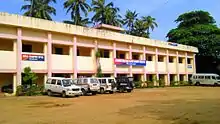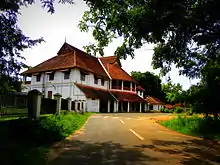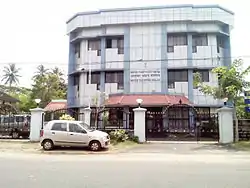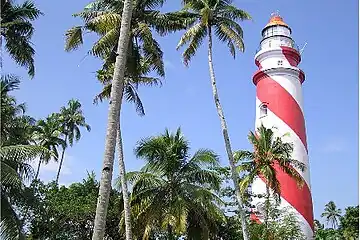Kollam District has four types of administrative hierarchies:
- Taluk and Village administration managed by the provincial government of Kerala
- Panchayath Administration managed by the local bodies
- Parliament Constituencies for the federal government of India
- Assembly Constituencies for the provincial government of Kerala
Administration of Kollam city


Kollam City is a Municipal Corporation with elected Councillors from its 55 divisions. The Mayor, elected from among the councillors, generally represents the political party holding a majority. The Corporation Secretary heads the office of the corporation.

The present Mayor of Kollam Corporation is Honey Benjamin of CPI.[1]
The police administration of the city falls under the Kollam City Police Commissionerate which is headed by an IPS (Indian Police Service) cadre officer and he reports to the Inspector General of Police (IGP) Thiruvananthapuram Range. The police administration comes under the State Home Department of the Government of Kerala. Kollam City is divided into three subdivisions, Karunagappally, Kollam and Chathannoor, each under an Assistant Commissioner of Police.
Urban structure
With a total urban population of 1,187,158[2] and 349,033 as city corporation's population, Kollam is the fourth most populous city in the state and 49th on the list of the most populous urban agglomerations in India. As of 2011 the city's urban growth rate of 154.59% was the second highest in the state.[3] The Metropolitan area of Kollam includes Uliyakovil, Adichanalloor, Adinad, Ayanivelikulangara, Chavara, Elampalloor, Eravipuram (Part), Kallelibhagom, Karunagappally, Kollam, Kottamkara, Kulasekharapuram, Mayyanad, Meenad, Nedumpana, Neendakara, Oachira, Panayam, Panmana, Paravur, Perinad, Poothakkulam, Thazhuthala, Thodiyoor, Thrikkadavoor, Thrikkaruva, Thrikkovilvattom, and Vadakkumthala.[4]
The Kerala Government has decided to develop the City of Kollam as a "Port City of Kerala". Regeneration of the Maruthadi-Eravipuram area including construction of facilities for fishing, tourism and entertainment projects will be implemented as part of the project[5]
Kollam district

The history of the district's administration can be traced back to 1835, when the Travancore state consisted of two revenue divisions with headquarters at Kollam and Kottayam. When Travancore and Cochin were combined into Travancore-Cochin, Kollam was one of the three revenue divisions. When the state of Kerala was formed in 1957, Chenkotta taluk was merged with the state of Madras. Later in 1957, the Cherthala, Ambalapuzha, Mavelikara, Karthikapalli, Chengannur and Thiruvalla taluks (formerly in Kollam district) were united to form the new district of Alappuzha. In 1983, Pathanamthitta taluk and nine villages of Kunnathur taluk were removed from Kollam district to form the new Pathanamthitta district.[6]
District administration

Kollam district has six administrative subdivisions (taluks): Pathanapuram (new taluk), Punalur, Kunnathur, Kottarakkara, Karunagappally and Kollam. The district collector, a key functionary of the government, heads the district administration. The district collector is the agent of government and chief administrator of the district and reports to the state government. Among other tasks, maintaining law and order is a priority for district collector. The district collector is also the head of the Land Revenue Department of the district. The district has one revenue division, with its headquarters at Quilon. For administrative purposes, Kollam district is divided into 6 taluks, 11 blocks, 68 Panchayats, 1 corporation, 4 municipalities and 104 villages. The Kollam Civil Station was built in 1956 to incorporate all government offices in one place.
Police administration
Police administration in Kollam is divided into two districts: urban and rural. The City Police is headed by a City Police Commissioner, an IPS (Indian Police Service) officer with the rank of SP; its headquarters is at Kollam. The rural police is headed by the Rural Superintendent of Police (SP), with its headquarters at Kottarakkara. Both heads report to the Inspector General of Police (IGP), Thiruvananthapuram Range (Kerala)
The Kollam City Police is divided into three subdivisions, each under an Assistant Commissioner of Police (ACP): Karunagappally, Kollam and Chathannoor. Each subdivision is divided into circles, headed by the Circle Inspector of Police. Each circle is divided into a number of police stations, headed by a Sub-Inspector of Police. The Kollam Rural Police District is divided into two subdivisions, each under a Deputy Superintendent of Police (DySP): Kottarakkara and Punalur. There are a total of 29 police stations, in 13 circles. Kollam city traffic is controlled by the City Traffic Police, with a Traffic Police Station located near the Asramam Ground. Kerala's first coastal police station was established in Neendakara, Kollam.[7]
The first police museum in India (The Sardar Vallabhbhai Patel Police Museum ) has a large collection of police artefacts and rare photographs. The museum has a room dedicated to officers killed in the line of duty.[7] The forensic section has a large collection of photographs. The museum is located at the Kollam East Police Station.
Taluks
Kollam is administratively divided into 6 taluks. They are Kollam, Karunagappally, Kunnathur, Kottarakkara, Punalur and Pathanapuram, which are subdivided into 104 villages. The tahsildar is the revenue official in charge of each taluk.
| Taluk | Headquarters |
|---|---|
| Kollam Taluk | Kollam |
| Karunagappally Taluk | Karunagappally |
| Kunnathur Taluk | Sasthamkotta |
| Kottarakkara Taluk | Kottarakkara |
| Punalur Taluk | Punalur |
| Pathanapuram Taluk | Pathanapuram |
Municipalities
There are four municipalities in Kollam District. Punalur, Paravur, Karunagappally and Kottarakkara are the municipalities. There is a long-standing demand for upgrading Pathanapuram & Anchal panchayaths into municipal status.
Kollam (Lok Sabha constituency)
Kollam Lok Sabha constituency (Malayalam: കൊല്ലം (ലോക്സഭാ നിയോജകമണ്ഡലം) (formerly Quilon Lok Sabha constituency) is one of the 20 Lok Sabha constituencies in Kerala state in southern India.
Assembly segments
Before delimitation of parliamentary constituencies, Kollam Lok Sabha constituency was composed of the following assembly segments:[8]
After delimitation of parliamentary constituencies in 2008, presently Kollam Lok Sabha constituency comprises the following assembly segments:
- Chavara
- Punalur
- Chadayamangalam
- Kundara
- Kollam
- Eravipuram
- Chathannoor
Corporations and municipalities coming under Kollam Lok Sabha constituency
Members of Parliament
From Quilon cum Mavelikara constituency in Travancore-Cochin:
From Quilon/Kollam constituency in Kerala:
- 1957: Kodiyan, Communist Party of India
- 1962: N. Sreekantan Nair, Revolutionary Socialist Party
- 1967: N. Sreekantan Nair, Independent
- 1971: N. Sreekantan Nair, Revolutionary Socialist Party
- 1977: N. Sreekantan Nair, Revolutionary Socialist Party
- 1980: B.K. Nair, Indian National Congress (I)
- 1984: S. Krishna Kumar, Indian National Congress
- 1989: S. Krishna Kumar, Indian National Congress
- 1991: S. Krishna Kumar, Indian National Congress
- 1996: N. K. Premachandran, Revolutionary Socialist Party
- 1998: N. K. Premachandran, Revolutionary Socialist Party
- 1999: P. Rajendran, Communist Party of India (Marxist)
- 2004: P. Rajendran, Communist Party of India (Marxist)
- 2009: N. Peethambarakurup, Indian National Congress
- 2014: N. K. Premachandran, Revolutionary Socialist Party
Indian general election, 2014
| Party | Candidate | Votes | % | ±% | |
|---|---|---|---|---|---|
| RSP | N K Premachandran | 408,528 | 46.47% | N/A | |
| CPI(M) | M A Baby | 370,879 | 42.19% | -3.00% | |
| BJP | P M Velayudhan | 58,671 | 6.67% | +2.27% | |
| NOTA | None of the above | 7,876 | 0.90% | --- | |
| Margin of victory | 37,649 | 4.28% | +1.95% | ||
| Turnout | 879,056 | 72.12 | |||
| UDF hold | Swing | ||||
See also
References
- ↑ "CPI(M) rides to power in five of six corporations in Kerala". Economic Times. 18 November 2015. Retrieved 25 November 2015.
- ↑ "Kollam District Level Statistics 2011" (PDF). ecostat.kerala.gov.in. 2012. Archived from the original (PDF) on 2 January 2014. Retrieved 1 January 2014.
- ↑ "ANALYSIS OF CENSUS DATA - Census of India Website" (PDF). censusindia.gov.in.
- ↑ "Kollam city population Census". census2011.co.in. Retrieved 16 December 2013.
- ↑ "Kollam - Port City Project". 2013.
- ↑ Administration page of quilon.com
- 1 2 "kollam police official website". Archived from the original on 11 January 2016. Retrieved 4 August 2016.
- ↑ "Assembly Constituencies - Corresponding Districts and Parliamentary Constituencies" (PDF). Kerala. Election Commission of India. Archived from the original (PDF) on 30 October 2008. Retrieved 20 October 2008.
